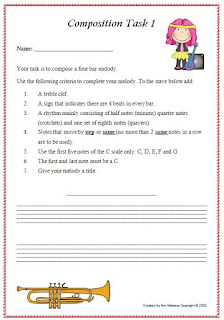“Inspiration is an awakening, a quickening of all man’s faculties, and it is manifested in all high artistic achievements,” (Puccini). While fostering musical creativity, composition can challenge students to understand the world in new ways as well as being a process that allows children to grow, discover, and create through meaningful engagement with sounds (Bauer, 2014). After reading this week’s assignment, I have decided to reflect on certain guidelines that teachers (including myself) should utilize when conquering a composition project in the elementary music classroom.
The two most common approaches include standard musical notation and non-notational compositional strategies (Bauer, 2014). Teachers who choose the standard musical notation approach believe it is essential for students to be musically literate (be able to read and notate music). While I agree with this approach, it tends to lose popularity with non-music students (those not in chorus, band, etc). At an elementary level, it is essential for students to know the basics (rhythms, pitches, solfege) but I also agree with the text when it explains how the non-notational approach is more successful with non-music kids. I have a mixture of students who are obsessed with music and others who want nothing to do with it. So, the non-notational approach to creativity, usually facilitated through technology, can be used as an entry point to further the development of non-music students’ understanding of music while holding their interest at the same time. Programs that would be useful include: Noteflight, Soundation, MuseScore and Soundtrap.
Music-COMP: Music Composition Online Mentoring Program is an online program that encourages & supports students in composing and arranging music (Bauer, 2014). In the text, Music Learning Today, it lists several guiding beliefs that can be used as a generic timeline when begining a compositonal project. The second belief says to begin composition with structured guidelines. When creating these guidelines, teachers should make sure there is a healthy balance of constraints and freedom of choice. While providing limiting options does facilitate creativity (especially during beginning stages), there should still be some freedom of choice. Gradually allowing students more decisions during the compositional process can eventually lead to more independence as composers and in music. The third belief of Music-COMP is that teachers should critique and reflect frequently. “Feedback is an important component of all learning” (Bauer, 2014). Feedback shows students and teachers to what extent learning has been successful and what strengths and weaknesses are apparent. Students will need to learn the basic three-step critique process if they are not familiar already.
3-Step Critique Process (Bauer, 2014)
- Student is given a positive comment
- Student receives constructive comments regarding areas for improvement
- Student receives another sincere, positive comment
Music-COMP Teachers also have guidelines that are provided in the text, Music Learning Today, that I believe are very significant to consider before starting a project. Students need to listen and discuss music in order to build an aural vocabulary, teachers must start at a point that is appropriate for the developmental level of students, and starting with small projects that are highly structured. The second guideline is one that I personally struggle with especially when you have students that are at different developmental levels because they learn at different rates. I suggest a pre-test that covers all the basics (rhythm, meter, melody, etc) to screen a baseline before starting any compositional projects.
After reflecting more on the subject of composition, it forced me to take a step back and look at the process in which I take when doing these projects. I could blame time constraints on my lack of structured guidelines but I now see how I can make this possible and what steps I need to take in order to be successful. Just knowing that I can take a non-notational approach (without feeling guilty) which can foster musical understanding in the long run makes the idea of doing a composition project less intimidating.
Listed below are some starter tools for beginner compositions. After completing projects such as these, you can extend the project by having your students put their compositions into a web-based program such as Noteflight or Soundation (both are free versions) :
TeacherspayTeachers:
by Music Teacher Resources

by The Yellow Brick Road
References
Bauer, W. I. (2014). A conceptual framework for technology - Assisted music learning. In
Music Learning Today: Digital pedagogy for creating, performing, and
responding to music. New York, NY: Oxford University Press.

Kristen,
ReplyDeleteThank you for this excellent post! Though I noticed the section on standard music notational and non-notational techniques, this post made me think about the effectiveness of each technique. As you mentioned, it is difficult to teach standard notational techniques to students who have little or no interest in how music works. I have never taught general music, but I can imagine that a handful of students would shut down if they had to focus solely on standard notation.
Have you ever seen pictures or video of teachers using the floor to create staves? I have seen it a few times but never in person. It looks like teachers often introduce lines and spaces to their students using large visuals for notes (large bean bags, students, stuffed animals, etc.). I could see this being effective when teaching composition. Maybe students could create a piece in pairs or small groups using these floor staves and bean bags (or another material). This might be a great activity to introduce composition before moving to writing it down or saving it to a computer.
https://s-media-cache-ak0.pinimg.com/564x/65/f5/e5/65f5e5dfe1da9b202ae92e13a907e62d.jpg